Low-Complexity Joint Angle of Arrival and Time of Arrival Estimation of Multipath Signal in UWB System
Abstract
1. Introduction
2. Data Model
2.1. Single-Antenna Sensing Data Model
2.2. Proposed Array Antenna Sensing Data Model
3. Traditional Based Joint AOA and TOA Algorithm
3.1. 2D-MUSIC Method
3.2. Root-MUSIC Method
4. Proposed Algorithm
4.1. Theoretical Derivation
4.2. Separation of Multipath Signals under Unknown Waveforms
5. Computational Complexity and Estimation Performance
5.1. Computational Complexity
5.2. Simulation Parameters
5.3. Results and Discussion
6. Conclusions
- (1)
- The computational efficiency of the proposed algorithm is significantly higher than that of the 2D-MUSIC algorithm, the Root-MUSIC algorithm, and the ESPRIT algorithm.
- (2)
- At each SNR, the accuracy of AOA, TOA, and TDOA estimation of the proposed algorithm is basically the same as that of 2D-MUSIC and better than that of Root-MUSIC and ESPRIT.
- (3)
- At each snapshot number, the accuracy of AOA, TOA, and TDOA estimation of the proposed algorithm is basically the same as that of 2D-MUSIC and better than that of Root-MUSIC and ESPRIT.
- (4)
- In case of unknown prior information of the transmitted signal, the proposed method can still distinguish the main path signal, while the other methods fail.
Author Contributions
Funding
Data Availability Statement
Conflicts of Interest
Abbreviations
| AOA | Angle of Arrival |
| TOA | Time of Arrival |
| MUSIC | Multiple Signal Classification |
| 2D | Two-Dimensional |
| Esprit | estimation of signal parameters using rotational invariance techniques |
| GPS | Global Positioning System |
| UWB | Ultra-Wideband |
| S-V | Saleh-Valenzuela |
| 2D-MUSIC | Two-Dimensional Multiple Signal Classification |
| TDOA | Time Difference of Arrival |
| 1D | One-Dimensional |
| ULA | Uniform Linear Array |
| SNR | Signal-to-Noise Ratio |
| RMSE | Root Mean Square Error |
References
- Zhang, Q.; Li, J.; Li, Y.; Li, P. A DOA Tracking Method Based on Offset Compensation Using Nested Array. IEEE Trans. Circuits Syst. II Express Briefs 2022, 69, 1917–1921. [Google Scholar] [CrossRef]
- Vlachos, E.; Alexandropoulos, C.G.; Thompson, J. Massive MIMO Channel Estimation for Millimeter Wave Systems via Matrix Completion. IEEE Signal Process. Lett. 2022, 25, 1675–1679. [Google Scholar] [CrossRef]
- Mao, Z.; Liu, S.; Zhang, Y.D.; Han, L.; Huang, Y. Joint DoA-Range Estimation Using Space-Frequency Virtual Difference Coarray. IEEE Trans. Signal Process. 2022, 70, 2576–2592. [Google Scholar] [CrossRef]
- Bharadwaj, R.; Koul, S.K. Wearable UWB Technology for Daily Physical Activity Tracking, Detection, and Classification. IEEE Sens. J. 2022, 22, 20684–20694. [Google Scholar] [CrossRef]
- Ding, Y.; Jiang, D.; Liu, Y.; Zhang, D.; He, T. SmartLOC: Indoor Localization with Smartphone Anchors for On-Demand Delivery. In Proceedings of the ACM on Interactive, Mobile, Wearable and Ubiquitous Technologies (IMWUT), New York, NY, USA, 4–6 December 2021; pp. 1–24. [Google Scholar] [CrossRef]
- Niculescu, V.; Palossi, D.; Magno, M.; Benini, L. Energy-Efficient, Precise UWB-Based 3-D Localization of Sensor Nodes With a Nano-UAV. IEEE Internet Things J. 2023, 10, 5760–5777. [Google Scholar] [CrossRef]
- Yaacoub, T.; Dobre, O.A.; Youssef, R.; Radoi, E. Optimal Selection of Fourier Coefficients for Compressed Sensing-Based UWB Channel Estimation. IEEE Wirel. Commun. Lett. 2017, 6, 466–469. [Google Scholar] [CrossRef]
- Allebes, E.; Singh, G.; He, Y. A 3-to-10 GHz 180 pJ/b IEEE802.15.4z/4a IR-UWB Coherent Polar Transmitter in 28 nm CMOS with Asynchronous Amplitude Pulse-Shaping and Injection-Locked Phase Modulation. In Proceedings of the 2021 IEEE International Solid-State Circuits Conference (ISSCC), San Francisco, CA, USA, 13–22 February 2021; pp. 304–306. [Google Scholar] [CrossRef]
- Saleh, A.A.M.; Valenzuela, R.A. A statistical model for indoor multipath propagation. IEEE J. Sel. Areas Commun. 1987, 5, 128–137. [Google Scholar] [CrossRef]
- Feng, R.; Wang, C.X.; Huang, J.; Gao, X.Q.; Salous, S.; Haas, H. Classification and Comparison of Massive MIMO Propagation Channel Models. IEEE Internet Things J. 2022, 9, 23452–23471. [Google Scholar] [CrossRef]
- Hollosi, G. Distribution of ultra wideband (UWB) receive timestamps in dense indoor environment based on the Saleh-Valenzuela channel model. In Proceedings of the 2022 14th International Conference on Communications (COMM), Bucharest, Romania, 16–18 June 2022; pp. 1–5. [Google Scholar] [CrossRef]
- Wu, S.-H.; Zhang, Q.-Y.; Zhang, N.-T. TOA Estimation Based on Match-Filtering Detection for UWB Wireless Sensor Networks. J. Softw. 2009, 20, 3010–3022. [Google Scholar] [CrossRef]
- Liu, W.; Ding, H.; Huang, X.; Liu, Z. TOA Estimation in IR UWB Ranging with Energy Detection Receiver Using Received Signal Characteristics. IEEE Commun. Lett. 2012, 16, 738–741. [Google Scholar] [CrossRef]
- Liu, X.J.; Wang, Z.B.; Zheng, L. Simple energy envelope TOA estimation algorithm. Comput. Eng. Appl. 2012, 78–80. [Google Scholar] [CrossRef]
- Zhang, T.T.; Zhang, Q.Y.; Zhang, N.T. A Two-Step TOA Estimation Method Based on Energy Detection for IR-UWB Sensor Networks. In Proceedings of the 2009 Seventh Annual Communication Networks and Services Research Conference, Moncton, NB, Canada, 11–13 May 2009; pp. 139–145. [Google Scholar] [CrossRef]
- Pourkhaatoun, M.; Zekavat, S.A. Concatenated Spectrum Multi-Band TOA Estimation. In Proceedings of the 2011 IEEE 22nd International Symposium on Personal, Indoor and Mobile Radio Communications (PIMRC), Toronto, ON, Canada, 11–14 September 2011; pp. 1192–1196. [Google Scholar] [CrossRef]
- He, Z.M.; Ma, Y.; Tafazolli, R. Improved High Resolution TOA Estimation for OFDM-WLAN Based Indoor Ranging. IEEE Wirel. Commun. Lett. 2013, 2, 163–166. [Google Scholar] [CrossRef]
- Xu, H.L.; Yang, L.Q. ToA Estimation for MB-OFDM UWB by Suppressing Energy Leakage. In Proceedings of the 2010—MILCOM 2010 Military Communications Conference (MilCOM), San Jose, CA, USA, 31 October–3 November 2010; pp. 2381–2386. [Google Scholar] [CrossRef]
- Savic, V.; Larsson, E.G.; Ferrer-Coll, J.; Stenumgaard, P. Kernel Methods for Accurate UWB-Based Ranging with Reduced Complexity. IEEE Trans. Wirel. Commun. 2016, 15, 1783–1793. [Google Scholar] [CrossRef]
- Abbasi, A.; Liu, H. Novel Cascade CNN Algorithm for UWB Signal Denoising, Compressing, and ToA Estimation. In Proceedings of the 2021 IEEE 11th Annual Computing and Communication Workshop and Conference (CCWC), Las Vegas, NV, USA, 27–30 January 2021; pp. 0721–0725. [Google Scholar] [CrossRef]
- Abbasi, A.; Liu, H. OneAI—Novel Multipurpose Deep Learning Algorithms for UWB Wireless Networks. In Proceedings of the 2021 IEEE Workshop on Signal Processing Systems (SiPS), Coimbra, Portugal, 19–21 October 2021; pp. 129–133. [Google Scholar] [CrossRef]
- He, K.; Zhang, X.; Ren, S.; Sun, J. Deep Residual Learning for Image Recognition. In Proceedings of the 2016 IEEE Conference on Computer Vision and Pattern Recognition (CVPR), Las Vegas, NV, USA, 27–30 June 2016; pp. 770–778. [Google Scholar] [CrossRef]
- Navarro, M.; Najar, M. Joint estimation of TOA and DOA in IR-UWB. In Proceedings of the 2007 IEEE 8th Workshop on Signal Processing Advances in Wireless Communications(WPAWC), Helsinki, Finland, 17–20 June 2007; pp. 1–5. [Google Scholar] [CrossRef]
- Navarro, M.; Najar, M. Frequency Domain Joint TOA and DOA Estimation in IR-UWB. IEEE Trans. Wirel. Commun. 2011, 10, 3174–3184. [Google Scholar] [CrossRef]
- Wang, F.Q.; Zhang, X.F.; Wang, F. Joint Estimation of TOA and DOA in IR-UWB System Using a Successive MUSIC Algorithm. Wirel. Pers. Commun. 2014, 77, 2445–2464. [Google Scholar] [CrossRef]
- Li, Y.; Yu, J.; He, L.Y. TOA and DOA Estimation for IR-UWB Signals: An Efficient Algorithm by Improved Root-MUSIC. Wirel. Commun. Mob. Comput. 2021, 2021, 9960273. [Google Scholar] [CrossRef]
- Shen, C.; Guo, Y.J.; Yu, J.R.; Yang, J.B.; Xu, J.T. DFT-Based Joint TOA and DOA Estimation in Impulse Radio Ultra Wideband. J. Data Acquis. Process. 2022, 37, 1157–1168. [Google Scholar] [CrossRef]
- Gong, L.L.; Hu, Y.; Zhang, J.Y.; Zhao, G.F. Joint TOA and DOA Estimation for UWB Systems with Antenna Array via Doubled Frequency Sample Points and Extended Number of Clusters. Math. Probl. Eng. 2021, 2021, 7521573. [Google Scholar] [CrossRef]
- Hua, M.C.; Liu, H.C. Joint estimation of DOA and TOA for MB-OFDM UWB signals based on frequency-domain processing. IET Radar Sonar Navig. 2016, 2021, 1337–1346. [Google Scholar] [CrossRef]
- Sun, B.; Tan, B.; Wang, W.B.; Lohan, E.S. A Comparative Study of 3D UE Positioning in 5G New Radio with a Single Station. Sensors 2021, 21, 1178. [Google Scholar] [CrossRef]
- Xie, R.; Hu, D.; Luo, K.; Jiang, T. Performance Analysis of Joint Range-Velocity Estimator With 2D-MUSIC in OFDM Radar. IEEE Trans. Signal Process. 2021, 69, 4787–4800. [Google Scholar] [CrossRef]
- Zhu, Y.; Zhang, W.; Yi, H.; Xu, H. Enhanced Root-MUSIC Algorithm Based on Matrix Reconstruction for Frequency Estimation. Sensors 2023, 23, 1829. [Google Scholar] [CrossRef] [PubMed]
- Wu, Y.; Wakin, M.B.; Gerstoft, P. Gridless DOA Estimation With Multiple Frequencies. IEEE Trans. Signal Process. 2023, 71, 417–432. [Google Scholar] [CrossRef]
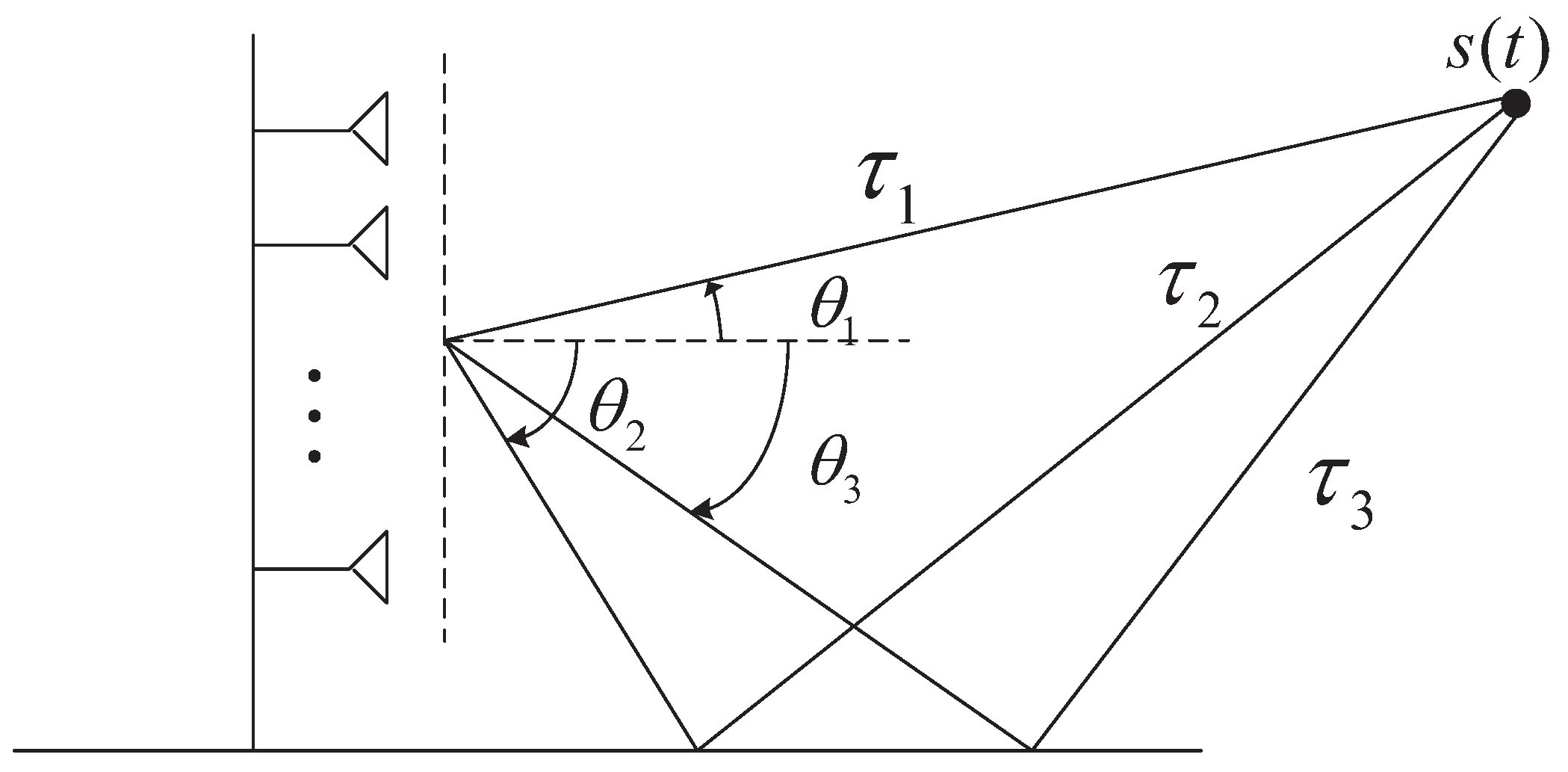

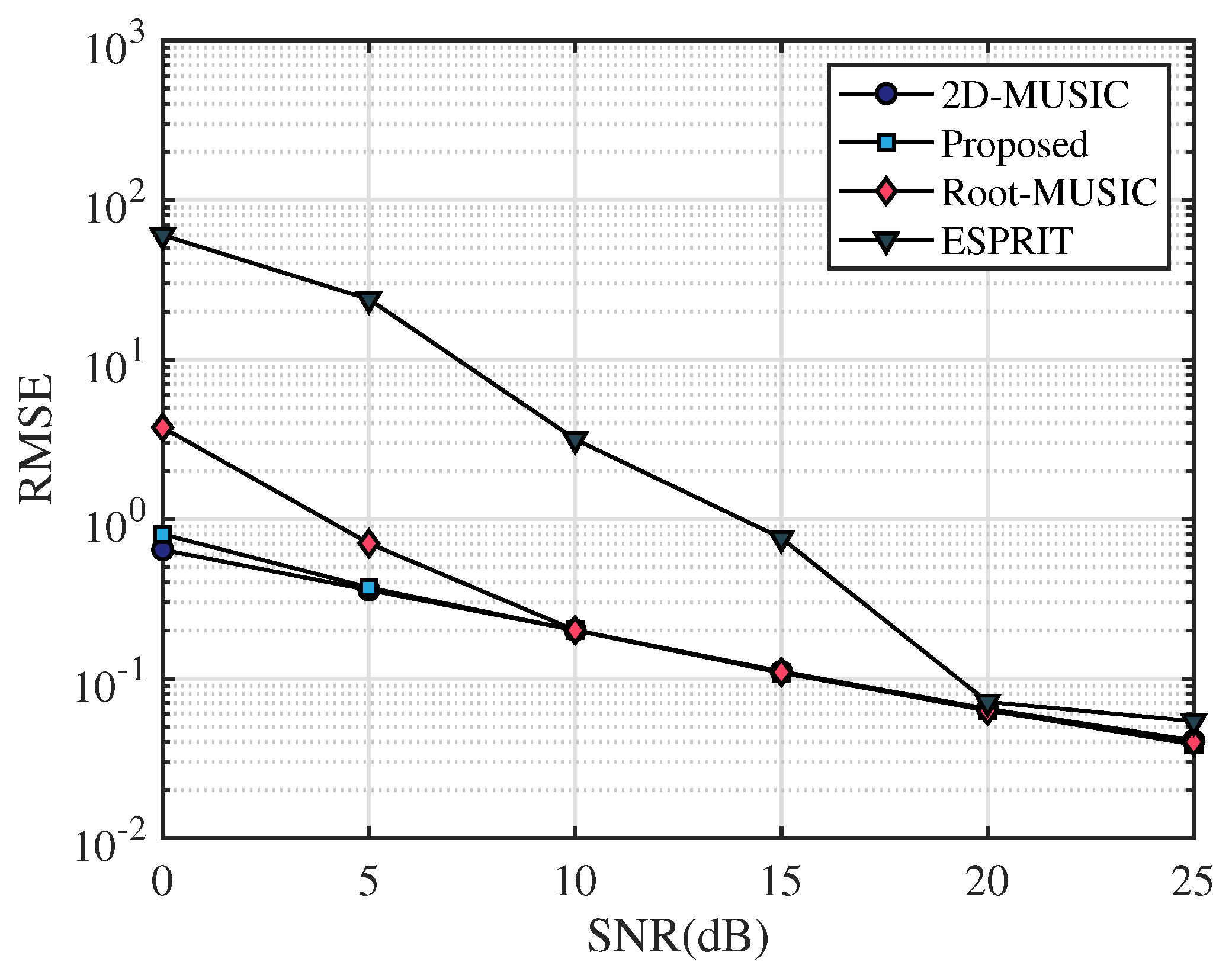
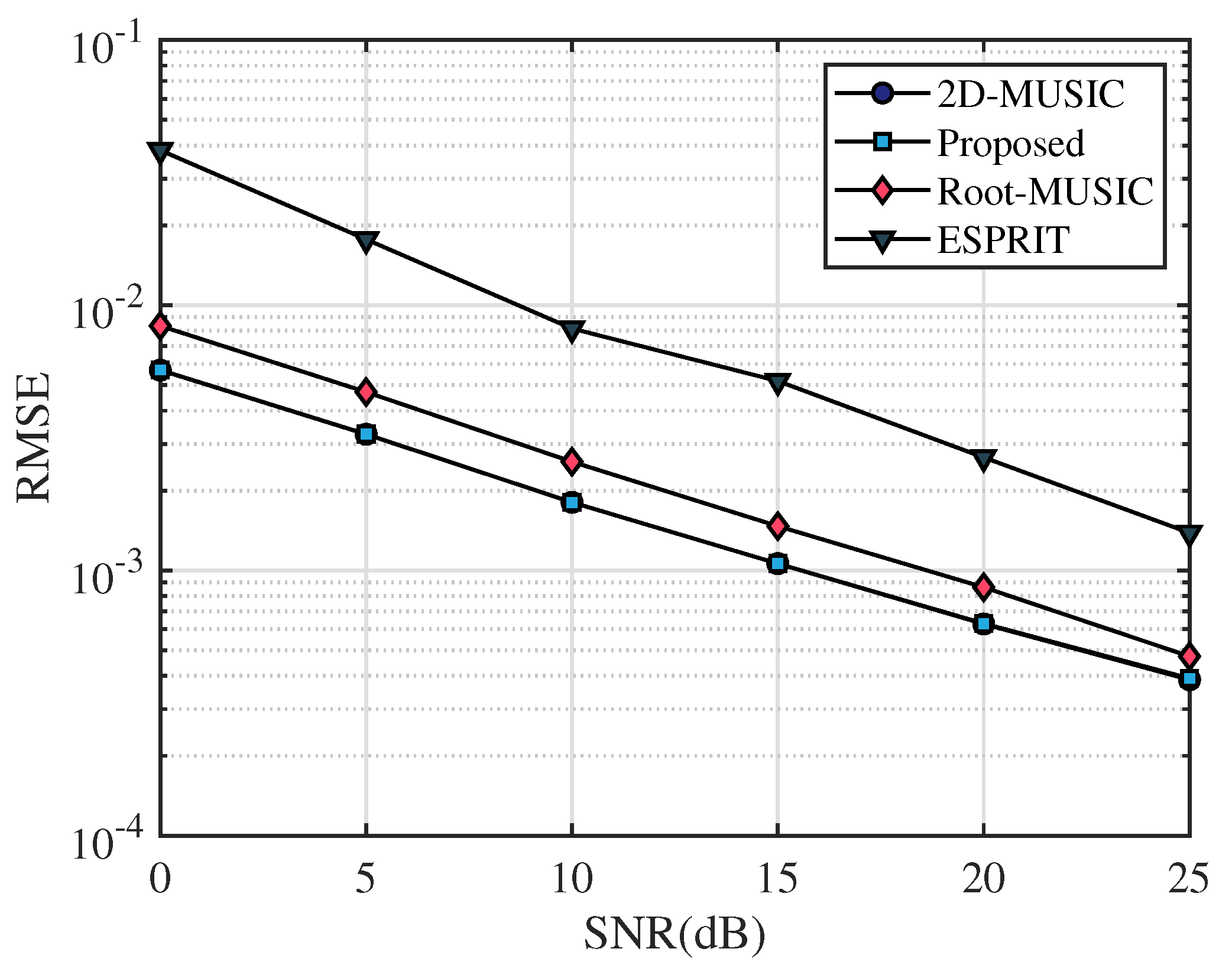
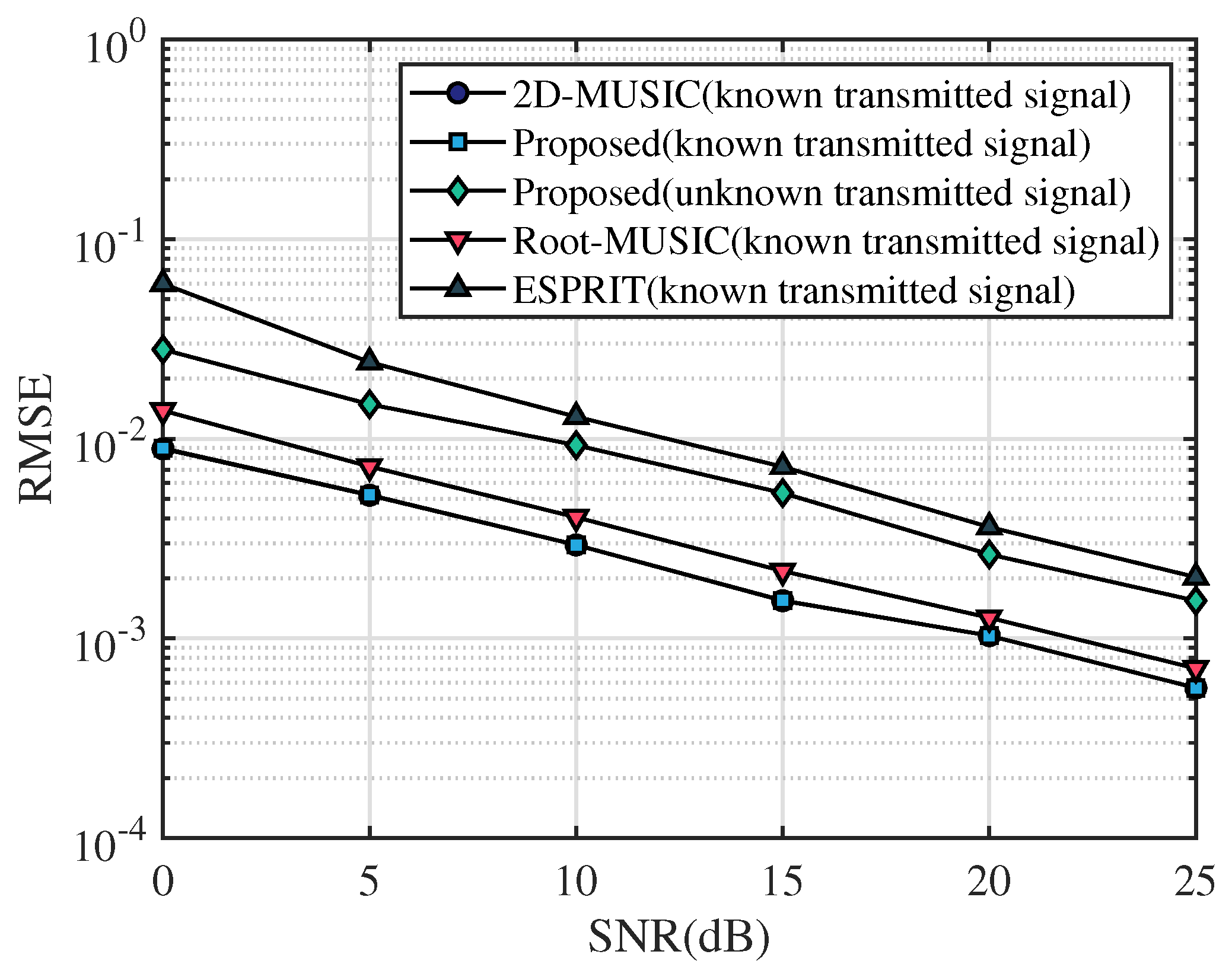
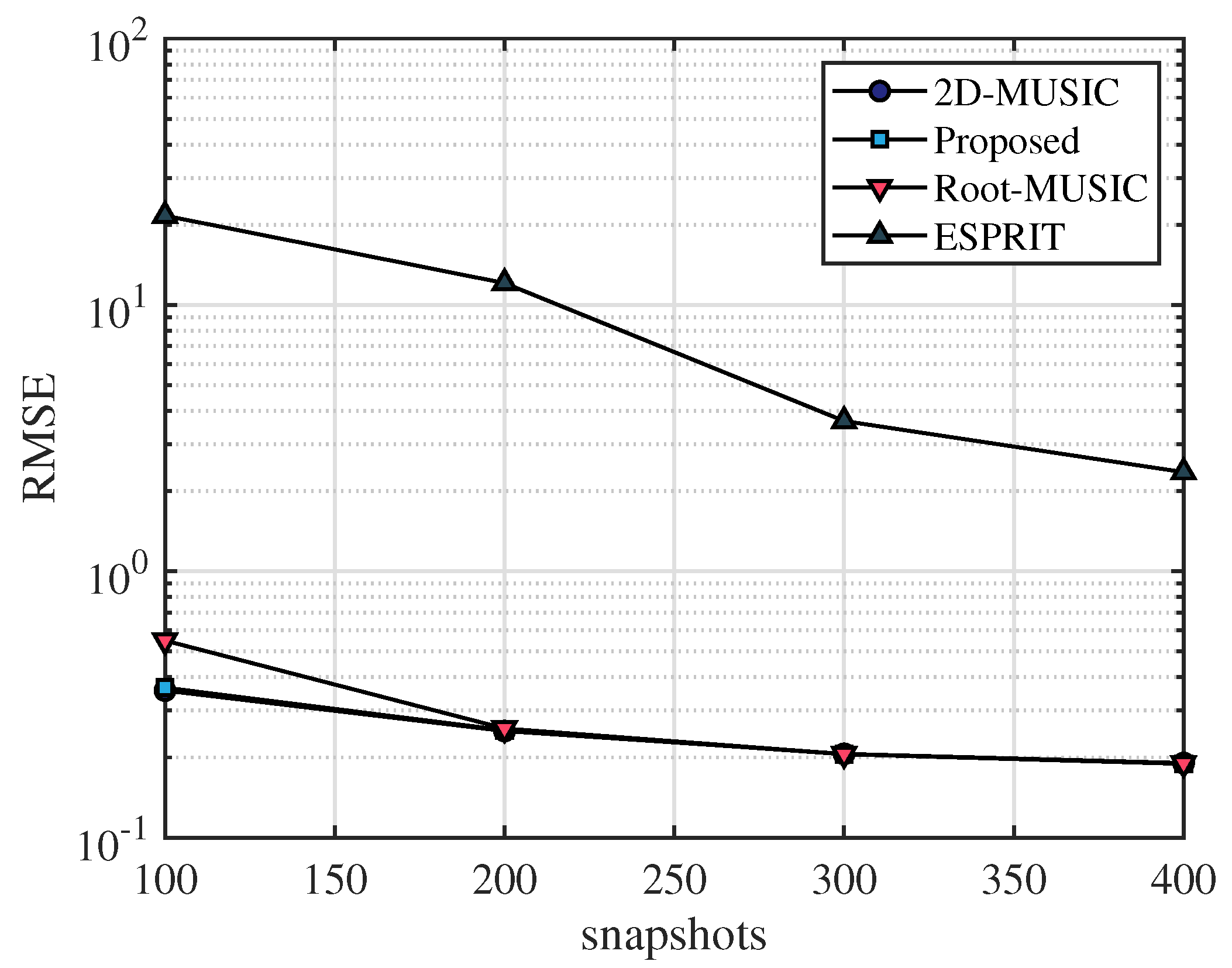
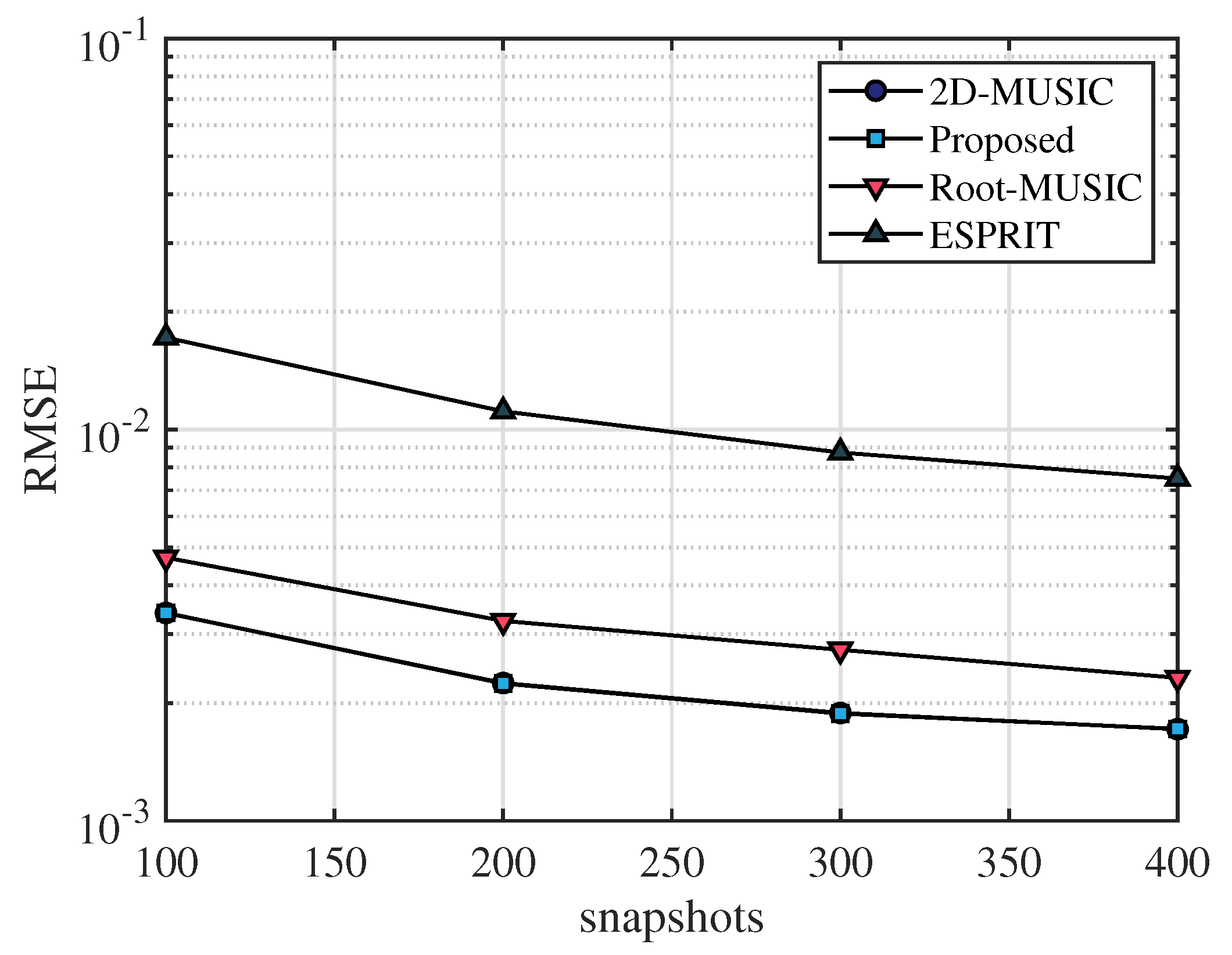
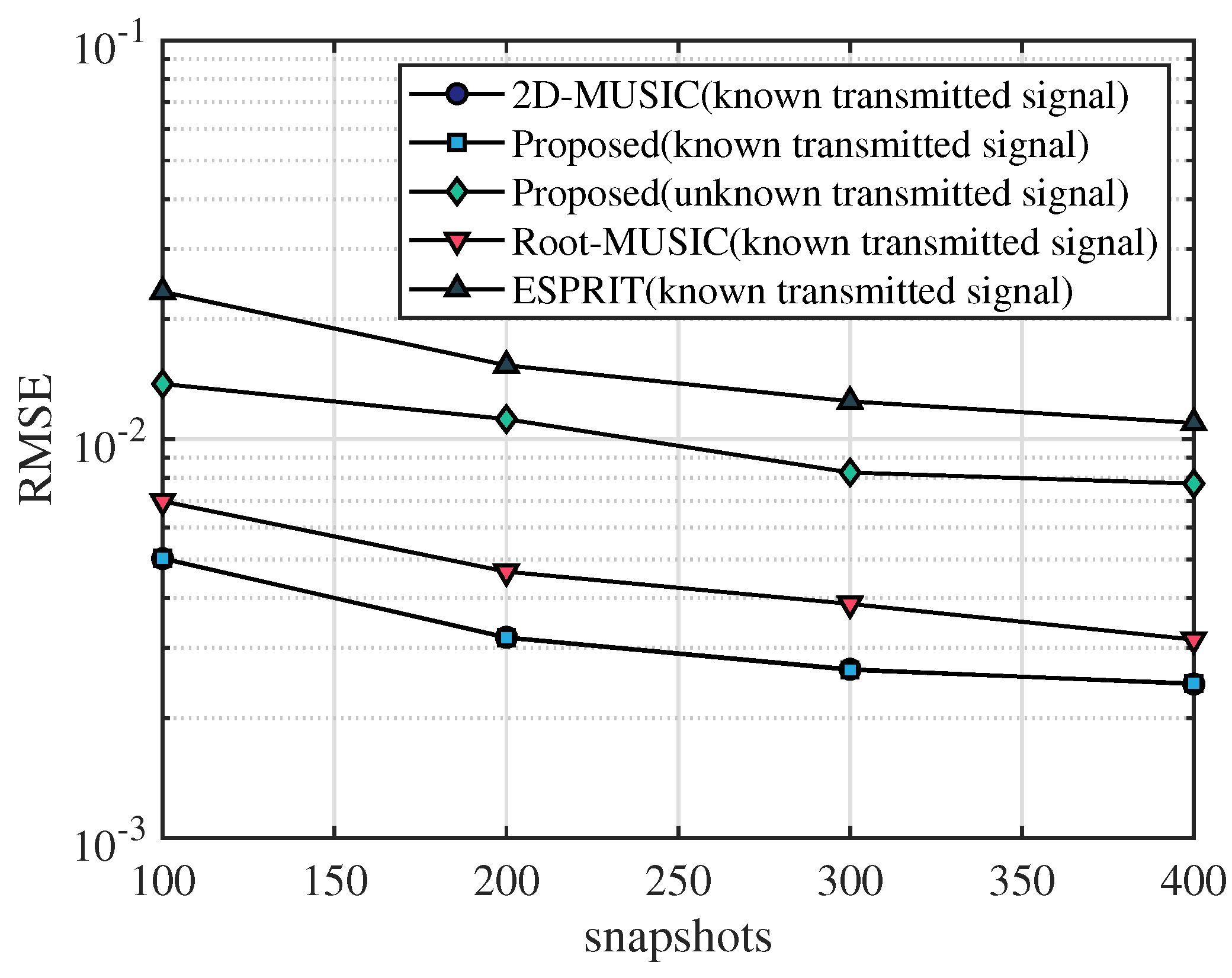
Disclaimer/Publisher’s Note: The statements, opinions and data contained in all publications are solely those of the individual author(s) and contributor(s) and not of MDPI and/or the editor(s). MDPI and/or the editor(s) disclaim responsibility for any injury to people or property resulting from any ideas, methods, instructions or products referred to in the content. |
© 2023 by the authors. Licensee MDPI, Basel, Switzerland. This article is an open access article distributed under the terms and conditions of the Creative Commons Attribution (CC BY) license (https://creativecommons.org/licenses/by/4.0/).
Share and Cite
Deng, W.; Li, J.; Tang, Y.; Zhang, X. Low-Complexity Joint Angle of Arrival and Time of Arrival Estimation of Multipath Signal in UWB System. Sensors 2023, 23, 6363. https://doi.org/10.3390/s23146363
Deng W, Li J, Tang Y, Zhang X. Low-Complexity Joint Angle of Arrival and Time of Arrival Estimation of Multipath Signal in UWB System. Sensors. 2023; 23(14):6363. https://doi.org/10.3390/s23146363
Chicago/Turabian StyleDeng, Weiming, Jianfeng Li, Yawei Tang, and Xiaofei Zhang. 2023. "Low-Complexity Joint Angle of Arrival and Time of Arrival Estimation of Multipath Signal in UWB System" Sensors 23, no. 14: 6363. https://doi.org/10.3390/s23146363
APA StyleDeng, W., Li, J., Tang, Y., & Zhang, X. (2023). Low-Complexity Joint Angle of Arrival and Time of Arrival Estimation of Multipath Signal in UWB System. Sensors, 23(14), 6363. https://doi.org/10.3390/s23146363






